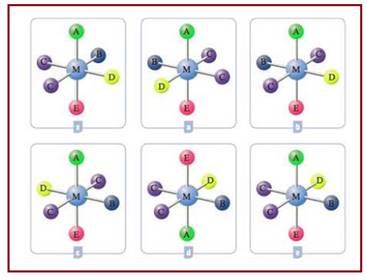
Concept explainers
(a)
Interpretation:
Following are the molecular models of octahedral complexes –

Figure 1
From the given molecular models of octahedral complexes the mirror images of the complex X has to be identified.
Concept Introduction:
Co-ordination compounds exhibit structural isomerism and stereoisomerism. Stereoisomerism deals with three dimensional spatial arrangements of atoms or groups of a molecule. There are two types of stereoisomerism – Geometric isomerism and optical isomerism.
A cis-isomer has two same ligands lying adjacent to each other whereas a trans-isomer has two same ligands lying opposite to each other.
In optical isomerism the isomer that rotates the plane of the polarized light in clockwise direction is termed as d-isomer and the isomer rotates the plane of the polarized light in anti-clockwise direction is l-isomer. These isomers are called optical isomers and they are non-superimposable mirror images.
(b)
Interpretation:
From the given molecular models of octahedral complexes the optical isomers of the complex X has to be identified.
Concept Introduction:
Co-ordination compounds exhibit structural isomerism and stereoisomerism. Stereoisomerism deals with three dimensional spatial arrangements of atoms or groups of a molecule. There are two types of stereoisomerism – Geometric isomerism and optical isomerism.
In optical isomerism the isomer that rotates the plane of the polarized light in clockwise direction is termed as d-isomer and the isomer rotates the plane of the polarized light in anti-clockwise direction is l-isomer. These isomers are called optical isomers and they are non-superimposable mirror images.
(c)
Interpretation:
From the given molecular models of octahedral complexes the distinct isomer of the complex X has to be identified.
Concept Introduction:
Co-ordination compounds exhibit structural isomerism and stereoisomerism. Stereoisomerism deals with three dimensional spatial arrangements of atoms or groups of a molecule. There are two types of stereoisomerism – Geometric isomerism and optical isomerism.
A cis-isomer has two same ligands lying adjacent to each other whereas a trans-isomer has two same ligands lying opposite to each other.
In optical isomerism the isomer that rotates the plane of the polarized light in clockwise direction is termed as d-isomer and the isomer rotates the plane of the polarized light in anti-clockwise direction is l-isomer. These isomers are called optical isomers and they are non-superimposable mirror images.
Trending nowThis is a popular solution!

Chapter 22 Solutions
Bundle: General Chemistry, Loose-leaf Version, 11th + OWLv2, 4 terms (24 months) Printed Access Card
- Q5: Label each chiral carbon in the following molecules as R or S. Make sure the stereocenter to which each of your R/S assignments belong is perfectly clear to the grader. (8pts) R OCH 3 CI H S 2pts for each R/S HO R H !!! I OH CI HN CI R Harrow_forwardCalculate the proton and carbon chemical shifts for this structurearrow_forwardA. B. b. Now consider the two bicyclic molecules A. and B. Note that A. is a dianion and B. is a neutral molecule. One of these molecules is a highly reactive compound first characterized in frozen noble gas matrices, that self-reacts rapidly at temperatures above liquid nitrogen temperature. The other compound was isolated at room temperature in the early 1960s, and is a stable ligand used in organometallic chemistry. Which molecule is the more stable molecule, and why?arrow_forward
- A mixture of C7H12O2, C9H9OCl, biphenyl and acetone was put together in a gas chromatography tube. Please decide from the GC resutls which correspond to the peak for C7,C9 and biphenyl and explain the reasoning based on GC results. Eliminate unnecessary peaks from Gas Chromatography results.arrow_forwardIs the molecule chiral, meso, or achiral? CI .CH3 H₂C CIarrow_forwardPLEASE HELP ! URGENT!arrow_forward
- Identify priority of the substituents: CH3arrow_forwardHow many chiral carbons are in the molecule? OH F CI Brarrow_forwardA mixture of three compounds Phen-A, Acet-B and Rin-C was analyzed using TLC with 1:9 ethanol: hexane as the mobile phase. The TLC plate showed three spots of R, 0.1 and 0.2 and 0.3. Which of the three compounds (Phen-A; Acet-B or Rin-C) would have the highest (Blank 1), middle (Blank 2) and lowest (Blank 3) spot respectively? 0 CH: 0 CH, 0 H.C OH H.CN OH Acet-B Rin-C phen-A A A <arrow_forward
 Principles of Modern ChemistryChemistryISBN:9781305079113Author:David W. Oxtoby, H. Pat Gillis, Laurie J. ButlerPublisher:Cengage Learning
Principles of Modern ChemistryChemistryISBN:9781305079113Author:David W. Oxtoby, H. Pat Gillis, Laurie J. ButlerPublisher:Cengage Learning Chemistry: Principles and ReactionsChemistryISBN:9781305079373Author:William L. Masterton, Cecile N. HurleyPublisher:Cengage Learning
Chemistry: Principles and ReactionsChemistryISBN:9781305079373Author:William L. Masterton, Cecile N. HurleyPublisher:Cengage Learning Chemistry: The Molecular ScienceChemistryISBN:9781285199047Author:John W. Moore, Conrad L. StanitskiPublisher:Cengage Learning
Chemistry: The Molecular ScienceChemistryISBN:9781285199047Author:John W. Moore, Conrad L. StanitskiPublisher:Cengage Learning Chemistry: Principles and PracticeChemistryISBN:9780534420123Author:Daniel L. Reger, Scott R. Goode, David W. Ball, Edward MercerPublisher:Cengage Learning
Chemistry: Principles and PracticeChemistryISBN:9780534420123Author:Daniel L. Reger, Scott R. Goode, David W. Ball, Edward MercerPublisher:Cengage Learning General Chemistry - Standalone book (MindTap Cour...ChemistryISBN:9781305580343Author:Steven D. Gammon, Ebbing, Darrell Ebbing, Steven D., Darrell; Gammon, Darrell Ebbing; Steven D. Gammon, Darrell D.; Gammon, Ebbing; Steven D. Gammon; DarrellPublisher:Cengage Learning
General Chemistry - Standalone book (MindTap Cour...ChemistryISBN:9781305580343Author:Steven D. Gammon, Ebbing, Darrell Ebbing, Steven D., Darrell; Gammon, Darrell Ebbing; Steven D. Gammon, Darrell D.; Gammon, Ebbing; Steven D. Gammon; DarrellPublisher:Cengage Learning ChemistryChemistryISBN:9781305957404Author:Steven S. Zumdahl, Susan A. Zumdahl, Donald J. DeCostePublisher:Cengage Learning
ChemistryChemistryISBN:9781305957404Author:Steven S. Zumdahl, Susan A. Zumdahl, Donald J. DeCostePublisher:Cengage Learning





